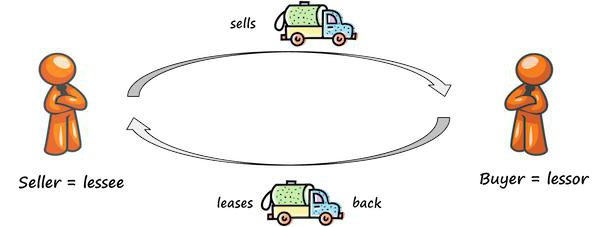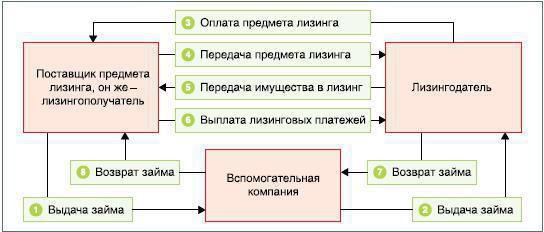Direct and leaseback are two financial transactions that allow you to receive assets that are not owned by the company without using them. This is especially beneficial if their value decreases over time. In a broad sense, leasing cars and any other assets is an agreement between two parties, under which one of them acquires the right to use them in exchange for monthly payments. This operation not only allows you to start using the equipment in the production process when there is no money to buy it, but also to keep it at home, actually selling it to the investor. We’ll talk about this in today's article.

History reference
Over the centuries, leasing has served many purposes. The essence of its legislative regulation depended on the socio-economic conditions in that period. In particular, until the beginning of the 19th century, leasing was most often used in the agricultural sector. Later it became a commonplace for city dwellers. Current legislation governing the relationship between the tenant and the owner of the property has developed under the influence of the “free hand” of the Adam Smith market and the principle of non-interference. Over time, amendments began to arise to protect the rights of the buyer. Ultimately, reforms have taken place in many countries that have made life easier for tenants. To date, both parties to the leasing agreement are protected in all developed countries almost equally.
Definition and general information
Return leasing is a financial transaction in which one market entity sells its asset and then leases it for the long term. Thus, he gets the opportunity to use equipment that he no longer owns. This operation is most often used for fixed assets, in particular, real estate, as well as durable means of production, for example, airplanes and trains. The term may be used by national governments to mean the sale and subsequent lease of their own territorial assets. The United States wanted to sell the Falkland Islands to Argentina and use leasebacks for future use over the next 99 years. A similar agreement was with China on Hong Kong. The use of such an operation is usually caused by financial or tax aspects of the business entity.

Return Leasing: Scheme
This financial transaction necessarily includes two participants. The first of them simultaneously acts as a seller of its property and a lessee. He loses ownership of equipment, real estate or vehicles, but gets the opportunity to continue to use them for a fee. Consider real estate leaseback:
- Take an asset off balance.
- Conclude a long-term contract under which returnable leasing will be carried out.
- Sell the property and make an advance payment.
- Spend money received from the lessor at its discretion.
- Continue to use the asset and pay monthly payments for it.
- Balance expenses by reducing taxable income enterprises.
- Upon the expiration of the contract, get the property back to your property.
You need to understand that if the lessee violates the terms of the agreement, the new owner can terminate the agreement unilaterally and refuse to return the asset.

Leaseback agreement
Under the terms of the agreement, after the purchase, the asset is transferred to the seller for a fee. The main reason for using such an operation as leaseback is the transfer of ownership of a holding company with the preservation of the value and profitability of the asset. Also, the seller can receive additional cash resources by transferring the household funds to the buyer. For the lessor, this transaction is a long-term secured investment. He may not worry about the loss of money or agreed interest, because he always has the opportunity to keep an asset in case the seller violates the terms of the contract. Return trusts to individuals are often practiced by investment trusts, which operate with a large number of real estate, from office premises to hospitals and apartments.

Key elements of the agreement
Leasing relations are secured by a legal contract. In the USA, he also has the features of a deal. Each type of leasing has its own special conditions, which are specified in the agreement. Generally form of contract includes the following aspects:
- Names of parties to the agreement.
- Starting date and term of the contract.
- Location of the leased asset.
- A condition regarding automatic renewal, if agreed upon by the parties.
- The size and frequency of payments for the use of the asset.
- Other conditions (insurance for losses, limitation of the use of property, maintenance and who is responsible for it).
- Clause on the termination of the contract (describes the situation when the contract ends ahead of schedule or is canceled).

Possible solutions to the problem of toxic banking assets
According to BBC business editor Robert Peston, one way to deal with the mortgage crisis is leaseback. He identifies two main advantages of this operation:
- There is no need to evaluate toxic assets.
- Losses from the latter are absorbed by banks in clearly fixed groups over the long term.

Reasons for Waiver of Ownership
Returnable equipment leasing usually begins with one party (usually a corporation) selling real estate to the other (most often an institutional investor or a trust fund). Then she rents her for a percentage of a certain term. The main reasons for conducting such a financial transaction are:
- Business expansion, purchase of new equipment for production, investment in new opportunities. Leasing cars or other assets allows a corporation to access greater capital than traditional financial mechanisms. Upon sale, the company gains access to 100% of the cost of household assets. Traditional financial arrangements limit the amount of norms of the ratio of loan to cost and coverage.
- Paying debts and improving the balance sheet of the company.
- A decrease in the tax obligations of the lessee, which is caused by an increase in the value of land and real estate. Moreover, the seller, renting premises, can deduct these payments as legal costs.
- Limiting the risks associated with owning real estate, for example, cyclical market fluctuations.
Benefits for the Lessor
An investor or trust fund, acquiring ownership of real estate or other assets, also has enough reasons for this. Among them:
- An honest return on investment in the form of rental payments throughout the leasing term, ownership of an amortized asset that already has a reliable tenant.
- Having a long-term asset asset agreement with guaranteed monthly payments.
- The ability to deduct investments in depreciable real estate, automobiles or equipment from the tax base, which will make it possible to quickly return the money spent on its acquisition.

Legal framework in different countries
Leaseback agreements are popular in France, USA, UK, Australia, Asia and even India. And there is a simple explanation for this. In France, the conclusion of such an agreement has significant tax benefits. Under the scheme, the seller can use the property from one to eight weeks per year (at most - six out of twelve months). The French government encourages, by providing tax benefits, leaseback in the tourism sector to alleviate the shortage of rental housing. The scheme can also be used when acquiring free land, which is then again given to the state for use. A typical leasing agreement is usually concluded in France for 9-11 years and can be continued.
In the United States, such a financial transaction is usually carried out with real estate. It is in the nature of a loan, where rental payments act as interest on it. Lack of funding is forcing more and more enterprises to resort to operations such as leaseback equipment. It allows you to quickly receive significant cash infusions. It should be noted that the contract can both provide for the return of ownership at the end of the term, and leave the property in the possession of the investor. In the first case, this happens at the end of the year in case of verification by the Internal Tax Service.
The concept of leaseback is widespread in European countries, particularly in Spain and Switzerland. The most commonly sold assets are studios, apartments and villas. Most often they are located near ski and beach resorts, golf clubs.








